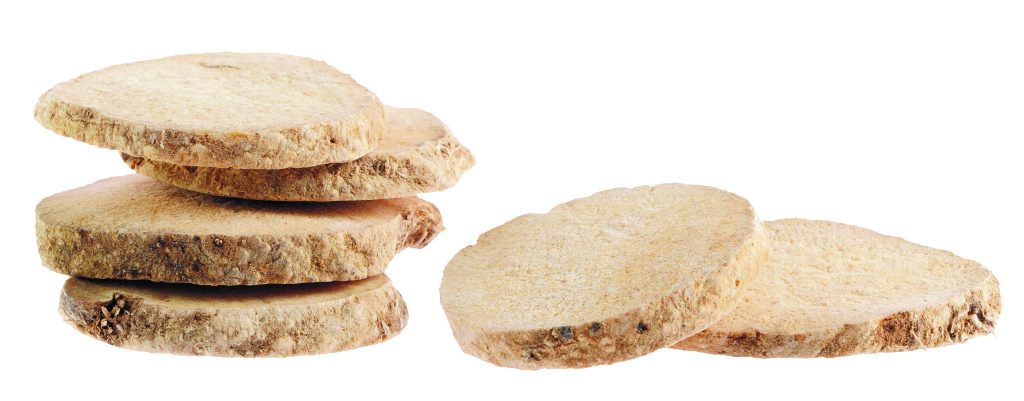Oriental Waterplantain Rhizome

What is Oriental Waterplantain Rhizome?
Oriental Waterplantain Rhizome (ze xie, 泽泻) refer to the roots of Oriental Waterplantain, a water plant that is also known as Alisma. This plant can be found throughout the marshlands of Asia. It is approximately three inches in height and one to two inches in diameter, which raised fibrous roots that are tuberous. After being harvested before the plant blooms, the roots are prepared through soaking in water before being cut into thick slices and dried under the Sun.
In ancient Taoist Chinese texts, Oriental Waterplantain Rhizome is described as a herb that if “taken for a long time, the eye and ear become acute, hunger is not felt, life is prolonged, the body becomes light, the complexion radiant, and one can walk upon water”. Also, according to the Flora of Pakistan, powdered Oriental Waterplantain Rhizome has been used as a cure for hydrophobia in many countries.
John Ruskin, a nineteenth century British art and social critic, also believed that the curve of the plant’s leaf-ribs were a model of “divine proportion”. This helped to shape his Theory of Gothic architecture, which was based on the use of natural forms.
In Traditional Chinese Medicine (TCM), Oriental Waterplantain Rhizome falls under the category of ‘Herbs that drain Dampness’. This herb can act as a diuretic by promoting the increased production of urine to remove Dampness that has accumulated in our bodies. Cold in nature, Oriental Waterplantain Rhizome can help individuals with too much Heat, such as those experiencing a Yang Excess or a Yin Deficiency, to restore a healthy yin-yang balance.
Sweet in taste, Oriental Waterplantain Rhizome can slow down acute reactions, detoxify the body and has a tonic effect on the body by replenishing qi and blood. In particular, the herb targets the Bladder and the Kidney.
Functions and Benefits of Oriental Waterplantain Rhizome
According to TCM, it is believed that Oriental Waterplantain Rhizome has the following health benefits:
Oriental Waterplantain Rhizome can induce diuresis to drain Dampness and Damp-Heat. This means that it can help to treat edema and dysuria caused by the accumulation of Dampness. Also. The herb can help to resolve phlegm-fluid, which addresses symptoms such as dizziness and vertigo caused by phlegm-fluid retention.
Other than inducing diuresis and draining Dampness, Oriental Waterplantain Rhizome can also clear Bladder Heat and purge Kidney Fire. This is why the herb is often indicated for symptoms associated with Damp Heat in the lower energizer. For example, the herb can address stranguria manifested as scanty and dark urine, dribbling, difficult and painful urination. It can also address diarrhoea caused by Dampness . Other symptoms that the herb can address include spermatorrhea, premature ejaculation, and nocturnal emissions associated with Kidney Fire. Additionally, the herb is used in yin-nourishing formulas to purge ministerial Fire and protect yin.
Modern studies have also suggested the herb may be beneficial in promoting weight loss. By lowering blood pressure, blood cholesterol and blood fats, Oriental Waterplantain Rhizome can also improve your blood health.
As Oriental Waterplantain Rhizome contains high amounts of calcium, the herb can also strengthen and facilitate the formation of muscles, teeth and bones. It helps to prevent bone-related diseases such as osteoporosis.
The herb may also help to promote sex drive, boost sterility, relieve fatigue and strengthen the immune system.

How to Use Oriental Waterplantain Rhizome
The recommended dosage of Oriental Waterplantain Rhizome is 5 – 10g. Some healthcare practitioners recommend 6 – 9g of Oriental Waterplantain Rhizome when mixed with water as a decoction. However, the exact dosage depends on the condition being treated.
Sliced, dried Oriental Waterplantain Rhizome can be found in many Asian markets and some specialty food stores. You can add the roots to your meals directly, or consume the herb in other forms such as powder or capsules. The herb in powdered form is often used as a cure for rabies. Oriental Waterplantain Rhizome Extract is a popular way to consume this herb too.
Cautions and Side Effects of Oriental Waterplantain Rhizome
Individuals who are experiencing sunken qi in the Middle Jiao should not use this herb. Pregnant or breastfeeding ladies should avoid this herb for the time being. Also, as Oriental Waterplantain Rhizome promotes urination, patients who are dehydrated or have difficulty retaining fluids in their bodies should avoid consuming this herb as well. For the same reason, patients who are consuming other diuretic drugs should not consume this herb too.
Overconsumption of Oriental Waterplantain Rhizome may result in side effects such as hematuria, electrolyte imbalance, vomiting, nausea, diarrhea, and abdominal pain.
Summary
Here is a summary for Oriental Waterplantain Rhizome (Ze Xie):
- Herb name (Chinese): 泽泻
- Herb name (Pin Yin): zé xiè
- Herb name (English): Oriental Waterplantain Rhizome
- Herb name (Botanical): Rhizoma Alismatis
- Origin of species: Alisma orientalis (Sam.) Juzep
- Part(s) of herb used: Tuber
- Geo-specific habitat(s): Fujian, Sichuan, Jiangxi
- Taste(s) & Properties: Sweet; Cold; Administrates the Kidney and Bladder Meridians
- Actions: Eases symptoms relating to water retention in the body; Relieves painful urination and premature ejaculation
Share this article on
